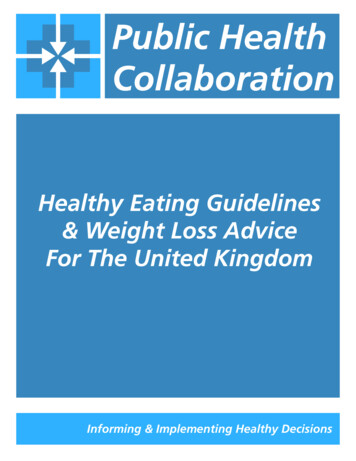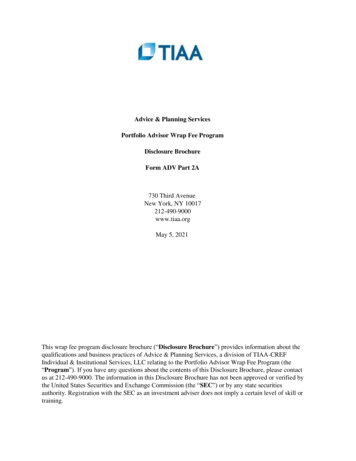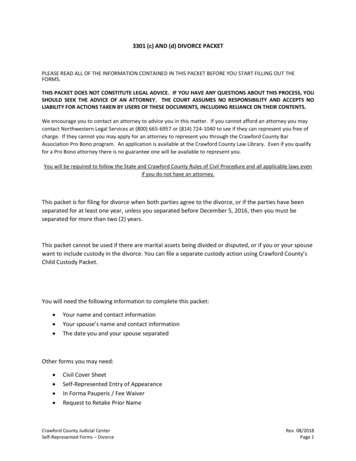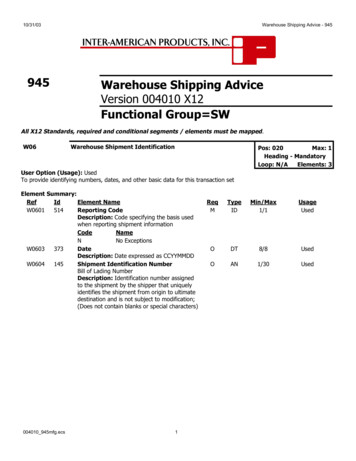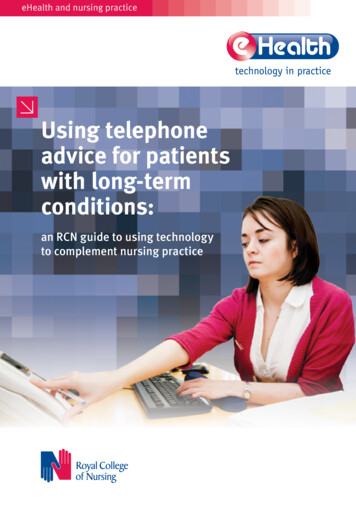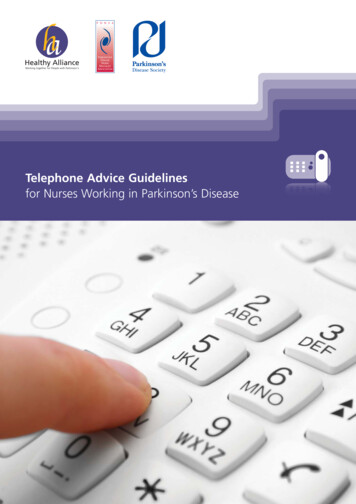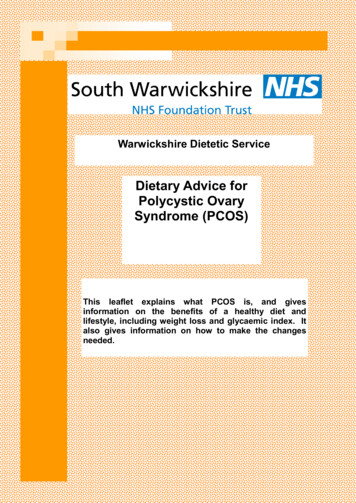
Transcription
Warwickshire Dietetic ServiceDietary Advice forPolycystic OvarySyndrome (PCOS)This leaflet explains what PCOS is, and givesinformation on the benefits of a healthy diet andlifestyle, including weight loss and glycaemic index. Italso gives information on how to make the changesneeded.
Dietary Advice for Polycystic Ovary SyndromeThe exact cause of PCOS is unknown. Many symptoms are caused by insulin resistance.The main symptoms include: Absent, infrequent or irregular periods Excess hair (hirsutism) particularly on your face, chest and stomach Difficulty controlling weight Thinning of hair Acne Infertility (problems conceiving) Tiredness Mood swings Raised cholesterol Under or over active thyroid Low self-esteem Depression.Long-term risksHaving PCOS can increase your risk of developing Type 2 diabetes and heart disease.TreatmentThere is currently no cure for PCOS, however, its symptoms may be improved by dietary andlifestyle changes, e.g. healthy eating, increased physical activity, cosmetic measures andmedication. Stopping smoking is also encouraged as part of a healthy lifestyle. Evidencehas shown that these dietary and lifestyle changes are the most effective treatment forPCOS.What is insulin?Insulin is a hormone made by the pancreas (an organ in the body) which helps take theglucose (sugar) in the blood to the cells to produce energy, so we can carry out the normalactivities of daily living.What is insulin resistance?Insulin resistance occurs when the body is producing insulin, but it is not working effectivelyso the glucose cannot be used by the cells. The body then produces more insulin tocompensate for this which causes high insulin levels in the blood. Unfortunately high insulinlevels favour weight gain and an increase in testosterone production. The diagram belowshows the cycle of weight gain with insulin resistance:Insulin resistancePancreas makes more insulinRaised testosterone causingacne, hirsutism, irregular periods,absent periods and infertility.Page 2Increased fat storagepromoting weight gain
Dietary Advice for Polycystic Ovary SyndromeDifficulty controlling weight?Some women with PCOS find it difficult to lose weight due to the effects of high insulin levels.Body weight represents the balance between energy intake from dietary sources and energyexpenditure through daily living. To enable weight loss, the energy you use must be greaterthan the energy (calories) you take in as food. This can be achieved by changing your dietand lifestyle in a way that is easy for you.Benefits of weight lossIt has been shown that a 5% weight loss can lower insulin levels which can improve periods,reduce hirsutism, reduce acne and can increase the chances of conceiving if you are tryingto get pregnant.Body Mass Index (BMI)BMI is used as a guide to measure if an individual is of a healthy weight, underweight oroverweight. It is calculated by:Weight (kg)Height (m2)16-19 underweight20-25 healthy weight26-30 overweight31-40 obeseYour BMI today is .Initial 5% weight loss target will be .Some hints for losing weight Do not try crash diets. These do not work in the long-term and you will benefit more frommaking life-long permanent healthier alterations to your diet. Set realistic, achievable targets; aim to lose no more than 0.5-1kg (1-2 lbs) per week. Make healthier changes to your diet. Avoid foods which are high in fat and sugar as these foods are high in calories. Fill up on fruit and vegetables. Consider keeping a food diary to record your intake. Make healthier changes with friends and/or family for additional support. Try to keep motivated and focused.Hints for a healthy balanced dietFood is an important part of our lives – not only does it provide us with energy, it gives us thenutrients, vitamins and minerals which our bodies need to function properly. No single foodcontains these nutrients, so a mixture of foods should be eaten.Page 3
Dietary Advice for Polycystic Ovary SyndromeEight principles of healthy eating:1. Enjoy your food.2. Eat a variety of different foods.3. Control your portion sizes (ask your Dietitian for further advice).4. Eat sensible amounts of carbohydrates and choose higher fibre varieties.5. Eat plenty of fruit and vegetables.6. Do not eat too many foods that contain a lot of fat and sugar.7. Drink plenty of fluids. If you drink alcohol, drink sensibly.8. Do not skip meals.The Eatwell PlateThe Eatwell Plate is a visual aid showing us the types and proportions of different foodswhich make up a healthy diet.Bread, rice, potatoes, pasta and other starchy foodsThis food group is an essential source of carbohydrate, and provides us with energy andhelps fill us up. It also provides us with fibre, B vitamins, iron and zinc. Although somestarchy carbohydrates are recommended with each meal it is very important to control yourportion sizes. Your Dietitian can individually advise you on recommended amounts ofcarbohydrates to eat. A portion is: 2-3 egg-size new potatoes1 medium baked potato (with skin)1 medium slice of bread30g breakfast cereal (3 tablespoons)1 WeetabixPage 4
Dietary Advice for Polycystic Ovary SyndromeFruit and vegetablesAim to have at least five portions of fresh, frozen, tinned, dried or juiced fruit and vegetables everyday. Try to eat a variety of fruit and vegetables as they all contain different essential vitamins,minerals and antioxidants and add colour, taste, texture and variety to your diet. Fruit andvegetables provide a healthy snack between meals. A portion is: A small glass of fruit juice (150 ml) 1 medium sized piece of fruit, e.g. banana, apple, orange, pear 2 small fruits, e.g. kiwi, plum, apricot A small handful of grapes, cherry tomatoes 2-3 heaped tablespoons of cooked vegetables 1 bowl of salad 1 slice of large fruit, e.g. melon, pineapple.Please note: fruit juice counts as only one portion regardless of how much you drink andpotatoes do not count towards the recommended five portions.Milk and dairy foodsDairy products provide a good source of calcium. You should aim to have 2-3 portions every day.A portion is: 200 ml milk150g yoghurt/fromage frais (small pot)40g cheese (small matchbox size)200g cottage cheese (large pot).For a healthy, balanced diet try lower fat varieties: Use skimmed, 1% or semi-skimmed milk instead of full cream milk .Use low fat cheeses, e.g. cottage cheese, Edam, half-fat cheddar.Try grating cheese instead of using slices.Try low fat yoghurts.Meat, fish, eggs and beansThis food group is essential for providing protein and minerals such as iron. You should aim for 23 portions daily. A portion is: 4 oz (112g) fish3 oz (84g) meat3 thin slices of lean meat2 eggs2 tablespoons of nuts4-5 tablespoons of lentils/beans.Tips Avoid roasting or frying in large amounts of oil or fat. Try to use healthy cooking methods including baking, grilling, microwaving, boiling andsteaming foods. Choose lean meat. Remove visible fat and skins from meat and poultry. Try to include one portion of oily fish (sardines, herring, kippers, pilchards, salmon,mackerel) a week.
Dietary Advice for Polycystic Ovary SyndromeFoods and drinks high in fat and/or sugarFoods containing fat are high in calories, and foods high in sugar will cause sharp rises inyour blood sugar levels. Therefore they should both be limited.Tips Use lower fat dairy products. Choose healthier cooking methods. Try using sweeteners instead of sugar in drinks and on cereals. Choose low calorie, sugar free or no added sugar drinks. Only eat sweets, puddings, cakes, chocolate, takeaways, pies and pastries occasionally.AlcoholAlcohol is high in calories and should be kept within sensible limits. Currentrecommendations are no more than 14 units a week for women. For women who do drink asmuch as 14 units per week, this is best spread out evenly over three days or more.A unit of alcohol will vary according to the strength, but is approximately: ½ pint (300 ml) of beer, bitter, lager or cidera pub measure (25 ml) of spirits such as gin, vodka, whisky or ruma small glass (125 ml) of wine.Confused by food labels?Reading food labels is a good way to find out how much fat and sugar is in pre-packagedfood.The two most important things to look out for are fat and sugar. It is best to look at the “per100 g” column because the portion sizes of foods tend to differ. This will make it difficult tocompare products. Using the “per 100 g” column will give a percentage of the amount of fatand sugar in the product.Guide to food labelling (per 100 g)Food per 100gSugarsFatOf which saturatesFibreSalt (Sodium)High levels22.5g17.5g5g3g1.5g (0.6g)Low levels5g3g1.5g0.5g0.3g (0.1g)Some food products have a traffic light labelling system which can show you healthieroptions.GREEN means the food is low in that nutrient, therefore, the healthiest choice.AMBER means the food is not high or low in the nutrient, therefore a moderately healthychoice.RED means the food is high in the nutrient, therefore the least healthy choice. Try to eatthese foods only occasionally.Page 6
Dietary Advice for Polycystic Ovary SyndromeThe Glycaemic Index (GI)GI is a measure of how quickly the carbohydrate and sugar contained in food is broken downand absorbed into the blood. Some foods produce a quick, high rise in blood sugars; thesehave a high GI. Those that produce a slower, smaller rise have a lower GI.How do I use GI?While following a healthy, balanced diet, using foods from the low or intermediate GI range(instead of those from the high GI range) can help to reduce your blood glucose levels.It is important to remember that some of the low GI foods have a high fat content,e.g. full-cream milk, because a high amount of fat in a food slows down how quickly thesugar will be released into your blood. It is important to follow a low fat diet so some of thelow GI foods, e.g. chocolate should be eaten in small amounts.FibreDietary fibre is important because it helps to control blood sugar levels and can help lowerthe GI of food. It may also help to lower blood cholesterol levels, maintain healthy bowelfunctions and fill you up. Higher-fibre sources include wholemeal and granary bread, fruitand vegetables, brown rice, brown pasta and potato skins.Here are some examples of GI rated foods:Food GroupLow GIIntermediate GIHigh GIFruit andvegetablesApple, dried apricots,grapes, berries, salad,orange, pearVegetablesBananas, melon,raisins, sultanasWatermelon,parsnips, pumpkin,swede, datesBreakfast cerealsPorridge, Oatibix,Allbran, NaturalMuesli, Sultana BranWeetabix, Puffed andShredded Wheat,Branflakes,Rice Krispies,Cheerios, CocoPops, CornflakesBreadsMultigrain, granary,heavy fruit loaf,chapattisPitta bread, rye andwholemeal bread,Ryvita, CrumpetsWhite bread,bagels, French stickPotatoes, rice,pastaPasta, noodles, easycook and basmati rice,sweet potatoes, yamsNew potatoes,boiled potatoesInstant potato, mash,jacket potato, chips,white riceMilk and dairyMilk and yoghurtsIce creamSnack foodsBanana cake,popcorn, nuts andseeds, chocolate(especially dark),oatcakesBeans, lentils,chickpeasMuffins,digestives, rich tea,crisps, rice cakesGrains and pulsesPage 7Couscous, milletAll sweets,morning coffeebiscuits, doughnut,iced cakes, wafers
Dietary Advice for Polycystic Ovary SyndromePhysical activityIncreasing your physical activity has a number of health benefits: It plays an important role in weight loss or weight maintenance. Makes your body more sensitive to insulin and so reduces insulin resistance. Improves heart and lung health.Even a small increase in exercise can help weight loss. It is recommended that adults do atleast 150 minutes of physical activity a week. Some women with PCOS feel tired after eatingwhich may be due to insulin resistance. A 10 minute walk after a meal may increase energylevels.Ideas for exercise include: Swimming, cycling, running, brisk walking. Exercise classes, e.g. Zumba, boxercise, body combat, spinning classes. Dance classes. A sport, e.g. netball, badminton, tennis, football.Examples of increasing the amount of exercise in your daily routine include: Walking upstairs instead of taking the lift. Walking the dog. Getting off the bus a few stops earlier. Parking your car further away from the shops and walk some of the way.Behaviour changesTo make life-long healthy eating changes to the diet, it is important to look at the external(events and situations) and internal factors (thoughts and feelings) which affect eating habitsand find ways to alter them. Here are some suggestions on how to make changes to helpyou:External factors Plan meals and shopping in advance so healthier foods are chosen. Store appropriate foods, e.g. fruit and vegetables in the house so you are more likely toeat these when hungry. Avoid or reduce the frequency of buying foods high in fat and sugar. Seek support from friends and family.Lapses in healthy eating are common. It is important not to give up after one lapse.Rewriting the list of benefits of losing weight and talking to people may help with motivation.Internal factors It is important to ask yourself why you want to eat. Is it due to hunger, boredom, orfeeling depressed or anxious? Research shows that food cravings last 15-30 minutes. Therefore, if you distract yourselffor 30 minutes, you will find the food craving will ease, e.g. clean your teeth, go for awalk. Make a list of alternative actions (phoning someone, going for a walk or cleaning) todistract yourself when dealing with a food craving to make it easier to avoid eatingwhen you are not hungry. Reward yourself when you lose weight with non-food rewards, e.g. clothes, amagazine, haircut, can help maintain motivation to lose weight.Page 8
Dietary Advice for Polycystic Ovary SyndromeFurther information:Verity - The PCOS Self-Help GroupNew Bond House124 New BondLondonW1S Polycysticovarian-syndromeBritish Dietetic Associationwww.bda.uk.com“Polycystic Ovary Syndrome (PCOS) The Facts” by M. Elsheikh and C. Murphy (2008) ISBN978-0-19-921368-9My Goals . . . . . . .Page 9
Equality StatementAt South Warwickshire NHS Foundation Trust we are fully committed to equality and diversity, bothas an employer and as a service provider. We have a policy statement in our Equality Strategy thatclearly outlines our commitment to equality for service users, patients and staff:You and your family have the right to be treated fairly and be routinely involved in decisionsabout your treatment and care. You can expect to be treated with dignity and respect. You willnot be discriminated against on any grounds including age, disability, gender reassignment,marriage and civil partnership, pregnancy and maternity, race, religion or belief, sex or sexualorientation.You have a responsibility to treat other service users, patients and our staff with dignity and respect.Our information for patients can also be made available in other languages, Braille, audio tape, discor in large print.PALSWe offer a Patient Advice Liaison Service (PALS). This is a confidential service for families to helpwith any questions or concerns about local health services.You can contact the service by the direct telephone line on 01926 600 054 by email:Pals@swft.nhs.uk or by calling in person to the PALS Office which is located in the Lakin RoadEntrance to the hospital.If you have any queries about your diet, please contact us on 01926 600818,selecting option 3.Dietetic DepartmentGeorge Eliot HospitalNuneatonAuthorRegistered DietitianDepartmentDieteticsContact No.01926 600818PublishedJanuary 2019ReviewJanuary 2024Version No.1.1SWH No.00789/A.14Dietetic DepartmentWarwick HospitalWarwick
Having PCOS can increase your risk of developing Type 2 diabetes and heart disease. Treatment There is currently no cure for PCOS, however, its symptoms may be improved by dietary and lif


